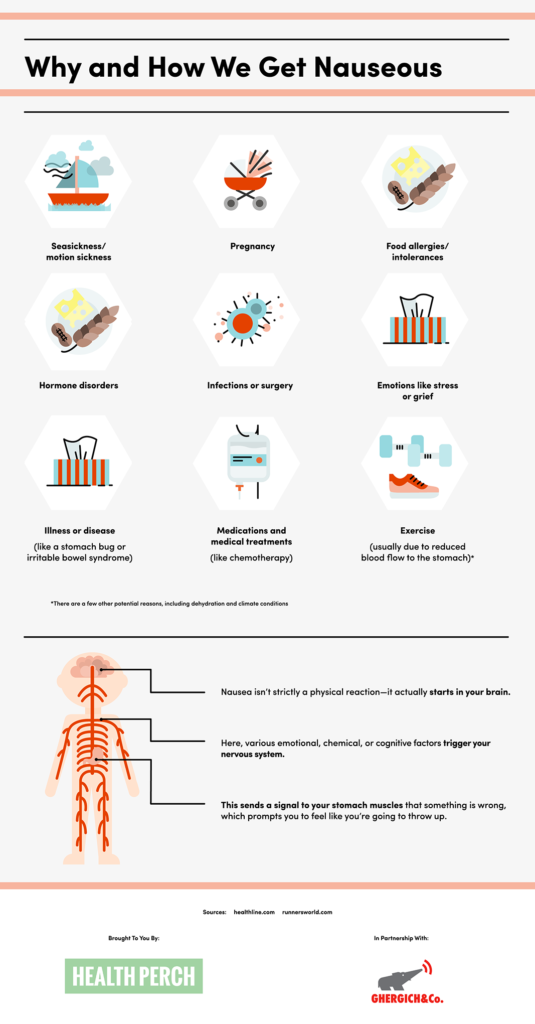Nausea is an extremely common symptom across a wide spectrum of diseases. It is one of the main symptoms in the ICHD3 diagnostic criteria for migraine. Nausea is one of the 3 “most bothersome migraine symptoms” (along with photophobia (sensitivity to light) and phonophobia (sensitivity to sound)) which most acute/abortive (as-needed) migraine medication clinical research studies assess as a primary data endpoint in trying to resolve, because it is such a disruptive symptom.
As the electrical activity of migraine spreads through the brainstem, it activates the nausea centers of the brainstem, and you are well aware of the misery that follows that. So, are there tricks or things that you can do to lessen nausea other than using standard antiemetics (anti-nausea) medications such as Metoclopramide (Reglan), Prochlorperazine (Compazine), Promethazine (Phenergan), and Ondansetron (Zofran)? Are there certain foods or drinks that can help lessen the nausea? I’ll give you the quick answer which is detailed below. Yes there are!!
You may be searching terms such as, what helps with nausea, what helps nausea, how to get rid of a stomach ache, home remedy for nausea, home remedy for stomach ache, feeling nauseous, upset stomach remedies, nausea remedies, what to eat when stomach is upset, stomach upset remedy, stomach upset home remedies, how to help nausea, home remedies for stomach upset, how to get rid of stomach ache, home remedies for stomach ache, stomach ache remedies, best foods for nausea, etc., etc.
Let’s talk about how to treat nausea symptoms naturally…
Occasionally, Virtual Headache Specialist will allow guest bloggers to write an article on a migraine related topic. How to treat nausea including natural treatments for nausea is one of those very relevant migraine associated topics. It is certainly not a symptom associated only with migraine, and has a very wide range of causes. Whatever the cause may be, it is a miserable symptom to have to deal with. So, I hope the following article gives you some additional firepower to add to your migraine treatment war chest in treating the migraine associated symptom of nausea!
FOODS THAT STOP NAUSEA IN ITS TRACKS.
Guest author: Kristen Seymour
Nausea: It’s one of those universal human experiences we can all commiserate with. In fact, it’s estimated that each year half of the adult population experiences at least one bout of nausea, which may or may not lead to vomiting. That makes sense because there are many reasons people feel nauseous.
WHAT TO EAT AND DRINK WHEN YOU FEEL NAUSEOUS
If you feel sick to your stomach, eating or drinking may be the last thing on your mind. And if your symptoms only last for a short time, abstaining could be the right thing to do.
However, if your symptoms persist for more than a couple of hours, not only is it important to stay hydrated (especially if you vomit or experience diarrhea) but there are some foods and drinks that can help quell your nausea, too. That said, if your symptoms persist for more than a day or are especially severe, you should contact your doctor.
WATER AND LIGHT OR CLEAR BEVERAGES
Even when you’re healthy, being dehydrated can leave you feeling pretty crummy. When you already feel awful, dehydration exacerbates the effect. And, if you have a fever and/or struggle to keep food or drinks down, you could become dangerously dehydrated without realizing it. Water alone is a great start, but if you lose fluids through vomiting or diarrhea, you may want to incorporate sips of coconut water, clear juices, or sports drinks. Flat ginger ale can also be a good option, but be cautious with carbonation as this could upset your stomach further.
Beverages and foods that are cold may be more appealing (or less likely to turn your stomach) than warm ones because they’re typically less fragrant. Sip small amounts rather than guzzling a whole glass, and consider sucking on small ice chips or a popsicle.
GINGER
This ancient herb has historically been used to relieve stomach upset, and the evidence that it works isn’t only anecdotal, it’s been proven in a variety of modern scientific studies, too. Keep in mind that effectiveness is tied to the amount consumed: Most studies use ½ to 1½ grams (or the equivalent) of dried ginger daily. But many common methods of consuming ginger (ginger tea, ginger ale, candied ginger slices, ginger cookies) make it hard to measure how much you’re getting. Taking ginger capsules or using your own fresh or dried ginger for tea is probably the best way to track your intake. If you’re pregnant or breastfeeding, talk to your doctor before using ginger for nausea.
BROTH OR SIMPLE SOUPS
When you’re ready to venture beyond clear fluids, broth is a great next step because it provides hydration, electrolytes, and a little more flavor, which may help you ease into real food. Broth is also a versatile base you can add more nutrition to in the form of chicken (diced small), vegetables, noodles, or rice as your body becomes capable of handling heartier fare. Just be sure to keep the spices and seasonings to a minimum at first.
BLAND, DRY STARCHY FOODS
Bread, crackers, rice, noodles, and other similarly simple foods are sick-day staples, although interestingly, this is one nausea-fighting food group that lacks scientific research to back up its effectiveness. It’s believed that starchy foods may help absorb some of the stomach acid that contributes to feeling nauseated, and it’s well-documented that we’re more likely to experience nausea on an empty stomach than when we’ve eaten a little something. So if you’re up for it, try nibbling on a soda cracker or a little steamed rice. You can add a small amount of seasoning, such as salt (or ginger) if it sounds appetizing.
APPLESAUCE
Not only is applesauce a gentle, healthy source of carbs (which can help you build back your energy), but it can also benefit you if you’re experiencing diarrhea. That’s because it has high dietary pectin, which helps by binding substances in the intestine, adding bulk to loose stools. Applesauce is part of the BRAT diet (bananas, rice, applesauce, and toast), which has long been a go-to grocery list for people with nausea.
BANANAS
Many of the foods on this list can soothe your stomach but lack in overall nutritional value. Not so with bananas. This nutrient-dense fruit is not only soft and easy to eat, it also provides you with approximately 105 calories, 27 grams of carbs, and 12 percent of potassium and 22 percent of vitamin B6 needs for the day (for a medium banana). One tip: The riper the banana, the more fragrant, so if smells turn you off, try a greener one.
HERBAL TEA
We mentioned that cold drinks are often more appealing than hot, but sometimes sipping on something warm provides much-needed comfort. In that case, try a caffeine-free herbal tea. See if perhaps peppermint, chamomile, or ginger sounds like something you’d like to sip. You may find that lukewarm or iced works better for you than hot.
Each person—and each instance of nausea—is different, so if you’re under the weather, don’t force yourself to eat a particular food if the smell turns your stomach. Listen to your body and take it slow; you’ll be back to your regular meals before long.
The original article can also be seen here, as originally published on Health Perch – A Digital Health Magazine.
IF YOU HAVE HEADACHE, MIGRAINE, OR FACIAL PAIN AND ARE LOOKING FOR ANSWERS ON ANYTHING RELATED TO IT, A HEADACHE SPECIALIST IS HERE TO HELP, FOR FREE!
FIRST, LET’S DECIDE WHERE TO START:
IF YOU HAVE AN EXISTING HEADACHE, MIGRAINE, OR FACIAL PAIN DIAGNOSIS AND ARE LOOKING FOR THE LATEST INFORMATION, HOT TOPICS, AND TREATMENT TIPS, VISIT OUR FREE BLOG OF HOT TOPICS AND HEADACHE TIPS HERE. THIS IS WHERE I WRITE AND CONDENSE A BROAD VARIETY OF COMMON AND COMPLEX MIGRAINE AND HEADACHE RELATED TOPICS INTO THE IMPORTANT FACTS AND HIGHLIGHTS YOU NEED TO KNOW, ALONG WITH PROVIDING FIRST HAND CLINICAL EXPERIENCE FROM THE PERSPECTIVE OF A HEADACHE SPECIALIST.
IF YOU DON’T HAVE AN EXISTING HEADACHE, MIGRAINE, OR FACIAL PAIN DIAGNOSIS AND ARE LOOKING FOR POSSIBLE TYPES OF HEADACHES OR FACIAL PAINS BASED ON YOUR SYMPTOMS, USE THE FREE HEADACHE AND FACIAL PAIN SYMPTOM CHECKER TOOL DEVELOPED BY A HEADACHE SPECIALIST NEUROLOGIST HERE!
IF YOU HAVE AN EXISTING HEADACHE, MIGRAINE, OR FACIAL PAIN DIAGNOSIS AND ARE LOOKING FOR FURTHER EDUCATION AND SELF-RESEARCH ON YOUR DIAGNOSIS, VISIT OUR FREE EDUCATION CENTER HERE.



